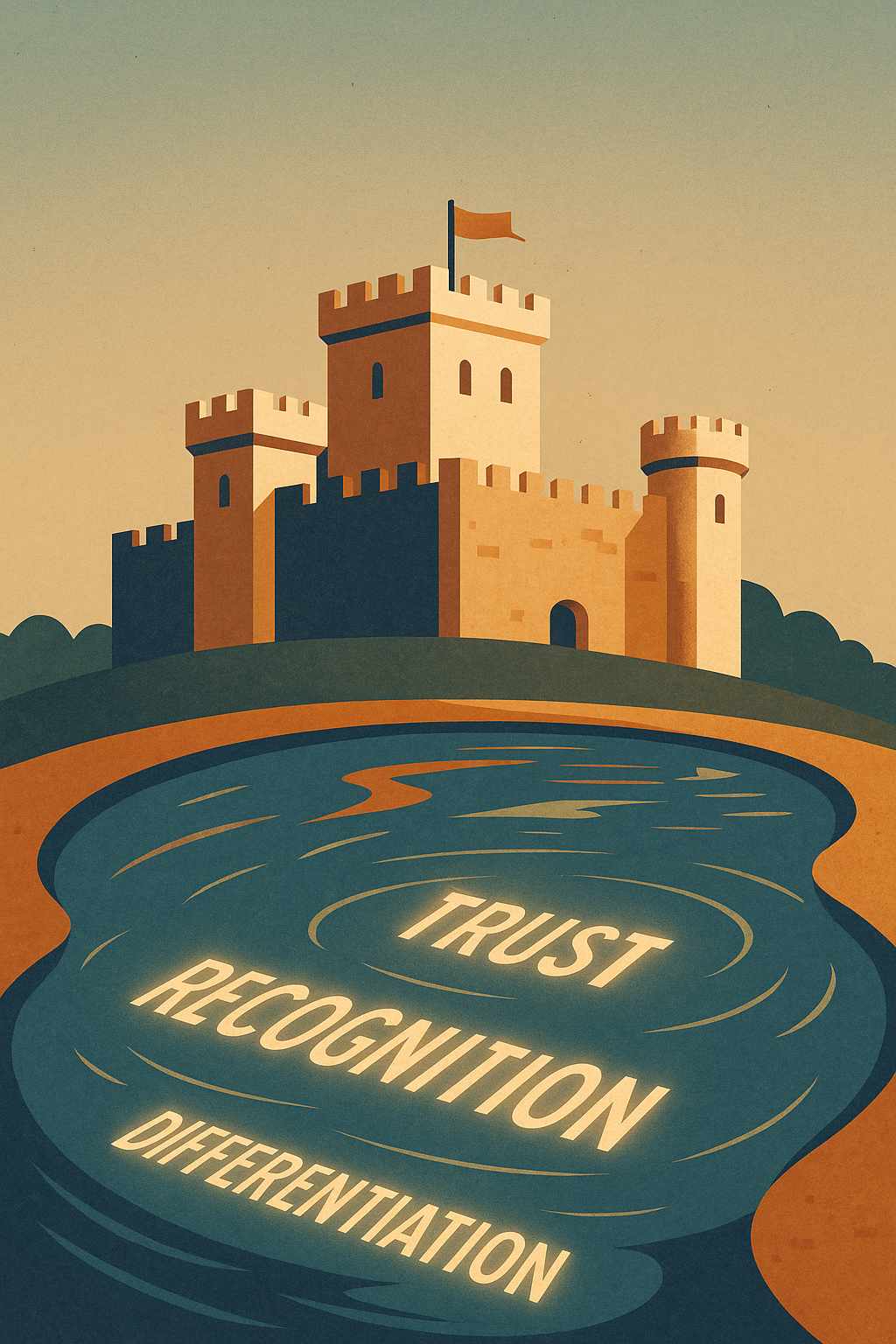You’ve got the talent, the team, and a product or service that could redefine your category—but here’s the catch: your brand isn’t pulling its weight.
Not because you don’t have one, but because it’s being treated like a line item in your marketing budget rather than what it truly is—a strategic asset.
The truth? Brands that lead markets don’t just look good; they think, act, and operate as the north star for every business decision.
And yet, far too many organizations—especially in B2B, tech, and professional services—are still caught in a transactional mindset, using branding as a cosmetic layer rather than embedding it as an engine for growth, trust, and differentiation.
I’m Viktor, a strategist who’s spent the last 13 years helping companies craft brands that win hearts, secure funding, and unlock new markets. This guide is going to change how you think about brand building—because it’s not about looking pretty, it’s about strategic clarity, competitive advantage, and business impact.
We’ll break down why your brand is your most powerful strategic tool—and how to start treating it that way. Let’s build a brand that doesn’t just say something but means something—across every touchpoint, platform, and decision.
Let’s get to work.
The Evolution of Branding as a Strategic Function
Branding once lived on the fringes of business strategy.
It was the visual garnish—logos, colors, typography—slapped on after the real work was done.
In many B2B industries, and even in fast-scaling startups, the brand was often viewed as an expense, relegated to the marketing function or a design team.
But that era is over.
Today’s strongest companies understand that a strategic brand is not just about how you look, but how you lead.
It’s not a deliverable—it’s a strategic asset that guides everything from product development to hiring practices.
In Blue Ocean Strategy, Kim and Mauborgne emphasized that real competitive advantage doesn’t come from fighting for market share in saturated “red oceans,” but from creating uncontested spaces of value.
Your brand isn’t decoration; it’s the vessel that carries your unique value proposition into that blue ocean.
This means branding is no longer an isolated act. It’s a strategic tool that permeates the business model.
A compelling brand doesn’t just support growth—it drives business growth.
It amplifies perceived value, fosters trust across platforms, and creates coherence across all channels. And in crowded markets, where products or services often seem interchangeable, a well-defined brand is the ultimate differentiator.
A brand must be built intentionally—not just designed, but architected.
It must connect across every touchpoint, influence every piece of content, and deliver a consistent voice and identity that builds recognition and trust over time. This is how modern businesses move from being remembered for their logos to being known for their lasting value.
Strategic Brand = Business Strategy
Here’s the shift: branding has become the central organizing principle of business strategy.
The most effective brands don’t bolt on messaging after a product is built—they embed brand thinking into the foundation of every strategic decision.
Think of your brand as the DNA of your organization. It informs your core values, aligns your teams, and acts as the internal compass that drives every department—from marketing and sales to HR, operations, and product development.
In The Effective Executive, Peter Drucker emphasized clarity of mission and purpose as central to organizational performance.
When that clarity is embodied in your brand’s identity, the result is not just messaging that sounds good—it’s alignment that scales.
Simon Sinek’s Start With Why expands on this by showing that people don’t buy what you do—they buy why you do it.
A truly strategic brand distills that “why” into every message, every experience, every digital interaction.
When you create content or launch products, it’s not just about functionality—it’s about fostering a sense of connection, illuminating a shared belief, and meaningfully differentiating in the minds of your customers.
Your brand must function as a strategic lens through which your entire organization operates. Not just a visual identity, but a strategic framework that guides culture, clarifies positioning, and cultivates emotional engagement.
A compelling brand doesn’t just win customers—it creates advocates. It attracts top talent, secures investors, and opens doors that raw performance data never could.
In this context, your brand is no longer a marketing artifact. It’s an intangible asset—arguably your most important one.
It shapes how customers perceive the brand, how partners engage with your organisation, and how your teams stay aligned toward long-term business success.
A well-designed brand, embedded strategically, is no longer optional—it’s the strategic asset that separates companies that thrive from those that vanish into obscurity.

A Well-Defined Brand Builds Trust and Drives Growth
Recognition, Relevance, and Resonance
In a digital-first world where attention is the scarcest currency, a well-defined brand does more than catch the eye—it earns trust, fosters connection, and drives action.
Recognition, relevance, and resonance are the three pillars that transform a brand from a name into a strategic asset.
It starts with visual identity—the typography, design, color palettes, and layout systems that form the immediate perception of your brand across platforms.
But consistency isn’t about aesthetics alone. A strong brand executes a cohesive narrative at every level, weaving clarity and familiarity into the customer experience.
This extends beyond your website or Instagram feed. A compelling strategic brand maintains a consistent voice across all touchpoints—from cold outreach emails and LinkedIn content to product packaging and internal presentations.
This brand’s voice should reflect not only your personality but your positioning: Are you consultative or visionary? Provocative or supportive? These attributes define how your customer relationships evolve and whether they scale.
The goal is not just recognition, but resonance—creating an emotional tether through every piece of content and every customer experience.
When your visual elements align with your brand’s personality, and your message stays relevant to your audience’s needs and aspirations, you create psychological safety. People don’t just remember your brand—they return to it. They trust it. They advocate for it.
And that trust? It isn’t soft power. It’s a measurable intangible asset that compounds over time.
Case Studies: Trust Translates to ROI
Let’s be clear—trust has an economic return. And the most iconic brands in the world know this.
Coca-Cola, for example, isn’t just a global beverage leader—it’s a global brand valued as much for its red-and-white label as for its product.
Its brand equity alone accounts for billions in market valuation. The company’s consistent use of visual identity, from logo to typography, and emotional storytelling has created a playbook for building a well-designed, emotionally charged brand that spans generations and geographies.
Airbnb took a different approach. As a platform brand, its strength lies not in physical product, but in the ability to effectively communicate trust and safety in a decentralized, peer-to-peer model.
Their building brand strategy focused heavily on fostering belonging, leveraging design, storytelling, and customer experience consistency to build trust in an unregulated category. The result? A multi-billion dollar valuation built not just on tech, but on brand-driven emotional trust.
In the B2B space, brands like Salesforce and HubSpot have become case studies in embedding brand strategy into the fabric of their platforms.
These aren’t just SaaS providers—they’re ecosystems, with a strong brand voice that influences customer onboarding, partner ecosystems, and even employee culture. Their brand’s voice resonates across all channels, from webinars to onboarding flows, reinforcing customer relationships and increasing LTV.
The throughline? A strategic brand is a powerful strategic tool—not just to drive impressions, but to create lasting value and accelerate business growth.
When management must choose where to invest, brand development isn’t a cost center—it’s an accelerator of trust, traction, and transformative growth.
Brand Identity: The Strategic Blueprint
The Key Components of a Strategic Brand
A strategic brand is not improvised—it’s architected. It’s a blueprint that defines how your business communicates, differentiates, and delivers value, not just externally but internally.
It’s how you create alignment, trust, and emotional resonance from the ground up.
At the heart of this blueprint lies your brand narrative—the overarching story that connects your mission to your market.
A strong narrative bridges the gap between your brand promise (what you say you do) and brand perception (what your audience believes you deliver). This delta is where most businesses either build loyalty—or lose it.
To close that gap, consistency is everything. Your brand’s voice—its tone, style, and personality—must be distinct and meaningfully reflect your values.
Whether you’re a tech scale-up or an ESG-focused B2B consultancy, your tone—bold, warm, disruptive, or authoritative—should be recognizable in every piece of content you publish. From pitch decks to social captions, that tone is your signature.
Then there’s typography—not just a design choice, but a strategic cue. Typography signals intent, reinforces mood, and guides user perception.
Paired with color and layout, these visual elements help ensure your identity doesn’t just exist—it performs.
They’re what make your brand well-designed across platforms, instantly recognizable on a billboard or a LinkedIn post.
Together, these components create more than a visual layer.
They form a powerful strategic tool—one that anchors your brand across all communications and keeps you top-of-mind in saturated markets.
Aligning Brand and Business Goals
A strategic asset is only valuable if it drives business results. That’s why brand identity can’t be siloed in marketing—it must be embedded in your organization’s DNA.
The most successful companies treat brand not as decoration but as a decision-making framework that influences everything from product development to hiring, partnerships, and ESG initiatives.
This begins with internal brand adoption.
Your team must understand, believe in, and articulate the brand—not just repeat taglines, but live the narrative.
When employees embrace the brand’s values and voice across functions, your business moves with clarity and coherence. Culture becomes brand in action.
But internal buy-in isn’t enough. To truly leverage brand as a strategic asset, it must be embedded across platforms and departments. Product teams should design with the brand promise in mind. Sales decks should reflect the brand’s voice. Operations should deliver on the customer experience expectations your message sets.
And leadership? They must champion the brand at every turn. As Peter Drucker and Jim Collins both emphasized: strategic clarity starts at the top. Without executive alignment, brand becomes fragmented. With it, it becomes exponential.
When you fuse brand identity with business strategy, you’re no longer just building a brand—you’re building a business that moves with purpose, speaks with one voice, and grows with intentionality. In a world where trust drives revenue and differentiation drives survival, that’s not just powerful—it’s essential.

Every Interaction Matters: Cohesion Across Digital Touchpoints
From Instagram Feeds to LinkedIn Content
In today’s hyper-connected world, your brand isn’t experienced in a linear funnel—it’s encountered across platforms, at every possible touchpoint, often out of sequence and without context.
That means every interaction must deliver with clarity, consistency, and purpose. Whether it’s an Instagram post, a LinkedIn article, a product landing page, or a webinar, each one must reinforce the same strategic brand narrative.
This is where content design becomes a strategic discipline—not just about aesthetics or tone, but about alignment.
Effective content considers three things: SEO, tone, and UX. SEO ensures discoverability, tone drives emotional resonance, and UX delivers usability and engagement.
Together, they allow your brand to not just reach people, but stick with them.
In DTC (Direct-to-Consumer), digital branding often prioritizes speed, trend agility, and emotional storytelling. In contrast, B2B brands must craft long-form authority, thought leadership, and trust—without losing the human tone that makes brands memorable. In both arenas, the bar is the same: create a well-designed digital presence that communicates a deep understanding of your audience’s world and how your products or services solve real problems.
The modern brand must speak fluently in every digital dialect, maintaining voice, purpose, and value across all formats and moments. This isn’t just marketing—it’s precision-aligned experience across channels.
Brand Playbooks and the Power of Consistency
Behind every cohesive brand is a playbook—a set of guardrails that empowers creative freedom while protecting brand integrity.
These playbooks are more than design systems; they are the operational codification of your brand narrative, voice, typography, and content principles.
They ensure that whether you’re launching a campaign, writing a sales email, or refreshing a webpage, your brand shows up coherently and strategically.
Consistency isn’t about monotony. It’s about fostering a sense of familiarity, reliability, and professionalism in every context. That’s what builds recognition and trust—not just with customers, but with partners, investors, and internal teams.
But consistency can’t exist in a vacuum—it must be enforced, iterated, and optimized. That’s where brand audits and health metrics come in. Tracking things like brand sentiment, content alignment, tone deviation, and platform-specific performance gives you real insight into how your strategic brand performs in the wild.
When you treat your brand like the strategic asset it is, you build systems of accountability around it. You use data to refine delivery. You review brand performance like you would any key asset—measurable, accountable, and iteratively improved.
Ultimately, every piece of content becomes a strategic lever. And when done right, every interaction—no matter how small—adds up to something far bigger: a powerful strategic tool that builds long-term value and deep, durable relationships.

Strategic Brand Management: The New C-Suite Priority
Brand Leadership as a Core Executive Function
In today’s business environment, brand is no longer a marketing afterthought.
A strategic brand informs not only how a company looks and sounds, but how it thinks, acts, and decides.
This means brand management must be deeply embedded in strategic decision-making, not confined to quarterly campaigns or aesthetic refreshes.
The modern CMO—or more accurately, the Chief Brand Officer—must transcend the role of campaign executor.
They must become a brand steward, someone who understands that the brand is a strategic asset shaping every business function, from pricing models and product development to M&A strategy and ESG initiatives.
Brand leaders today must operate with cross-functional fluency.
They must align the brand narrative with investor expectations, ensure brand consistency across platforms, and drive customer experience strategies that go beyond marketing into operations, sales, and culture.
When done right, brand leadership delivers not just visibility, but measurable business growth.
Companies like Apple, Patagonia, and Salesforce show what’s possible when building brand becomes a core executive function. Their market leadership isn’t accidental—it’s orchestrated through relentless brand clarity and executive alignment. This is the new mandate: treat brand as infrastructure, not decoration.
Attracting Top Talent and Strategic Partners
A strategic brand defines internal culture.
For fast-growth companies, especially in B2B and innovation-driven industries, the ability to attract top talent is a competitive edge.
And in a market where the best candidates choose companies aligned with their values, your brand becomes your loudest recruiter.
Candidates don’t just evaluate job descriptions—they evaluate brand signals: your tone of voice, your typography and design systems, your content strategy, your leadership’s presence on LinkedIn, and how consistently your brand fosters a sense of purpose.
In short, your brand communicates culture before a conversation even begins.
And it doesn’t stop at talent. Investors, partners, and acquirers all look for well-designed businesses—ones that can effectively communicate vision, differentiation, and operational maturity.
A brand that shows cohesion, clarity, and confidence becomes a trust multiplier in due diligence conversations. It shows you’re not just viable—you’re inevitable.
Whether you’re pitching a new partner, attracting a co-founder, or engaging a venture fund, your strategic brand is your proof of concept at scale.
It’s the lens through which your products or services are interpreted, your market positioning is understood, and your future potential is validated.
In the modern C-suite, brand is strategy. And those who fail to lead with it will follow those who do.

Creating a Brand That Resonates and Performs
Aligning Brand Message With Market Needs
To resonate in competitive markets, your brand message must align precisely with your audience’s needs, desires, and beliefs.
That requires more than intuition—it demands data, nuance, and deep semantic insight.
By leveraging natural language processing (NLP), semantic mapping, and audience intelligence tools, today’s brand strategists can understand how their market thinks, what language it uses, and what emotional triggers it responds to.
This enables the creation of a well-designed narrative that feels native to the audience while reinforcing core positioning. It’s the modern marketer’s superpower: using tech to drive empathy at scale.
But insight alone isn’t enough. You must translate it into a brand voice that conveys authenticity and intent.
Whether you’re building brand awareness for a B2B SaaS or launching a purpose-driven DTC product, your ability to emotionally differentiate—to foster a sense of shared values—will determine whether you’re chosen or forgotten.
This is emotional positioning: the art of crafting a brand that doesn’t just describe, but connects. From website copy to typography, from product descriptions to employer branding, your message must resonate across platforms, in every piece of content, and through every stakeholder interaction.
A brand that listens deeply and speaks clearly is not only heard—it’s felt. And that’s what builds relevance that lasts.
Turning Brand Equity Into a Competitive Moat
A truly strategic asset builds defensibility. Brand equity, when cultivated intentionally, becomes a competitive moat that’s hard to copy and impossible to ignore.
Peter Thiel’s Zero to One makes the case that all great businesses achieve monopoly by building durable differentiation. Your strategic brand is how you encode that differentiation into perception. It’s what enables you to command pricing power, reduce customer acquisition costs, and expand your footprint without diluting your message.
Jim Collins’ Good to Great reinforces this by highlighting how the best companies don’t chase trends—they clarify their hedgehog concept and build consistent messaging and action around it. When a brand delivers exactly what it promises, across all channels, experience across departments improves, and loyalty follows.
Jonah Berger’s Contagious shows how the most memorable ideas spread through social currency and emotional triggers.
When your brand becomes shareable, you gain more than visibility—you gain virality with purpose. Brands that create content people want to talk about build ecosystems, not just campaigns.
Ultimately, brand equity isn’t a static score—it’s a dynamic engine. It compounds every time someone shares your story, trusts your promise, or pays a premium for your products or services because they believe in who you are. And that equity becomes your moat—one that no competitor, no matter how well-funded, can simply replicate.
So build a brand that performs—but more importantly, build one that lasts.

From Perception to Performance: Measuring Brand Impact
Metrics That Matter
In the age of data-driven decision-making, brand performance must be as measurable as it is memorable.
Yet, many companies still reduce branding to aesthetics, tracking surface-level vanity metrics like follower counts or post likes—numbers that reveal attention but not alignment. A strategic brand, however, demands strategic KPIs.
Let’s be clear: a brand is a strategic asset, and like any asset, it must be evaluated for return on investment.
Start with brand valuation—a critical measure of how much your strategic brand contributes to your enterprise value. Global players like Apple, Microsoft, and Google routinely lead brand valuation rankings not just for their products, but for their brands’ ability to attract, retain, and command.
Next, consider Net Promoter Score (NPS)—a direct window into how well your products or services deliver on your brand promise. High NPS correlates with strong word-of-mouth, customer loyalty, and market momentum—especially in B2B, where long sales cycles hinge on trust.
Share of voice (SOV) is another critical benchmark. A high SOV in your category—earned through organic content, media mentions, and digital conversations—signals brand leadership. When you’re dominating the conversation, you’re influencing the perception of your space.
And don’t overlook brand sentiment. Sentiment analysis, powered by AI and NLP, offers a nuanced view into how your brand is perceived across platforms and in every piece of content. Are customers associating your strategic brand with trust, innovation, and consistency? Or is there a disconnect between your intent and public perception?
The future of brand measurement lies in connecting brand performance with business performance.
That means integrating brand health with broader strategic KPIs—customer lifetime value (CLV), retention rates, pipeline velocity, and even employee engagement. These are the metrics that prove brand is not just influence—it’s impact.
When a well-designed, strategic brand is executed and measured correctly, it becomes more than a message. It becomes a multiplier.

The Brand is the Strategy
Let’s end with this: a brand is not a logo. It’s not a tagline, a font, or a color scheme. It’s not a campaign. A strategic brand is your company’s competitive DNA—an enduring, dynamic force that drives alignment, trust, and performance.
Treating brand as a strategic asset means recognizing that every interaction—from a product landing page to a hiring email—is a brand moment. Every visual, every message, and every piece of content is an opportunity to foster a sense of consistency, value, and meaning. It’s what ensures your voice is clear, your values are visible, and your products or services are positioned for real-world traction.
In today’s crowded, fast-moving digital landscape, building a brand that performs isn’t optional—it’s existential. Especially in B2B and high-growth sectors, your brand must carry your strategy—not trail behind it. A well-designed identity, rooted in purpose and activated across platforms, becomes your most powerful strategic tool.
When you lead with brand, you lead with clarity. You illuminate what matters. You move markets. And you create an asset that compounds—delivering trust, traction, and transformation.
The companies that win? They don’t just have a brand—they are a brand.
Now is the time to elevate yours.









